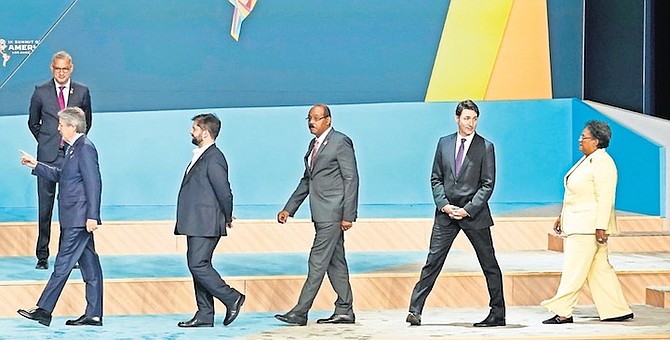FROM front left, Ecuador President Guillermo Lasso, Chilean President Gabriel Boric Font, Antigua and Barbuda’s Prime Minister Gaston Alphonso Browne, Canadian Prime Minister Justin Trudeau and Barbados Prime Minister Mia Amor Mottley at the Summit of the Americas. Photo: Marcio Jose Sanchez/AP
“The future of the Western Hemisphere is a responsibility of all the countries of this hemisphere. Irrespective of our size, or GDP, or our system of governance, we all have a shared interest in a sustainable, resilient and equitable future.”
– John Briceño, Prime Minister of Belize
MANY international summits, some more than others, are talkfests, mostly occasions for high-blown rhetoric and photo-ops, though substantive speeches, statements and diplomacy are often critical, including for domestic audiences.
There are typically bilateral meetings between countries where more business gets done and leaders can forge and renew alliances and relationships.
There are also regional meetings, including opportunities for smaller countries and blocs such as Caricom to press compelling challenges and meet collectively with leaders such as the US President.
Last week, 23 leaders of the Western Hemisphere met in Los Angeles for the ninth Summit of the Americas. The theme: “Building a Sustainable, Resilient, and Equitable Future.” It was the first time the meeting was held in the United States since the inaugural summit in Miami in 1994 hosted by Bill Clinton.
The hemispheric gathering has taken place in various capitals since 1994, though recently delayed by the COVID-19 pandemic.
The Americas are teeming with extraordinary diversity, though sharing common histories of colonialism, imperialism and slavery. The hemisphere includes the North American powers, Central America, the regions of South America and a diverse Caribbean.
Because of political and economic differences it is often difficult to forge common interests and consensus on a range of international issues. The touted hemispheric free trade agreement from 1994 never materialised. Such an agreement would be near impossible today.
This year’s summit focused on climate change, economic recovery, migration and other issues of mutual concern. The 2022 meeting had little of the excitement of the initial and subsequent summits when the United States enjoyed more regional gravitas, and China’s economic and diplomatic influence was less ubiquitous and growing.
Today, China is the leading trading partner for Brazil, Chile, Argentina and Peru, South America’s largest economies. China’s influence continues to grow in Central America.
SIGNIFICANT
While the United States retains significant security, economic and political ties with most countries in South and Central America, its “once-unchallenged leadership in its former ‘backyard’ has arguably descended to historic lows,” argues a well-known journalist in the Americas.
In an article in The Atlantic this week, former New York Times foreign correspondent William Neuman, observed: “That inaugural [summit] marked a moment of US ascendancy, as America stood atop a unipolar world after the collapse of the Soviet Union. Latin America was also going through a transformation, no longer a region of military dictatorships: Nearly every country had a democratically elected government, and many were eager to work with Washington.”
How considerably the world and the region have changed. And America, especially after the Trump presidency, appears unrecognisable in myriad ways.
The various summits of the Americas have always been circumscribed by the reality that various governments often prefer to do business with the United States bilaterally.
Summits often do not live up to the purple-prosed aspirations of the leaders of the day. But, how will last week’s gathering be remembered? The reviews may be mixed depending on the country.
A number of leaders, including the President of Mexico, boycotted the Summit because of the exclusion of Cuba, Venezuela and Guatemala.
As the veteran journalist and Latin America watcher Lucia Newman observed of the exclusion and boycott: “It is not an issue of support for those countries’ respective leaders, Daniel Ortega, Miguel Diaz Canel, and Nicolas Maduro. Most countries in the region consider them authoritarian and undemocratic, as does Washington.
“Biden and other regional leaders could have used the forum to hold Nicaragua, Cuba and Venezuela accountable on human rights and elections. And they could also have attempted to make headway on shared objectives.”
When President Obama went to his last summit, he and former Cuban President Raul Castro sat at the same table.
During a press conference on her return home from the Summit and a host of meetings, Barbados Prime Minister Mia Mottley seemed encouraged by the meeting between Caricom and President Biden and Vice President Kamala Harris. The Dominican Republic was also at this meeting.
Ms Mottley noted the main topics at the meeting: difficulty accessing financing, food and energy security, climate change and the ongoing economic fallout from COVID-19.
CLIMATE CHANGE
She emphasised the Caribbean needed much more than mitigation efforts in response to climate change. Ms Mottley stressed the need for funds for adaptation to make us more resilient to the effects of rising seas and more powerful storms.
During his plenary statement, Belizean Prime Minister and current Caricom Chair, John Briceño, called for action on “a multidimensional vulnerability index to determine access to grants and concessional development finance, so that countries like ours can affordably finance our recovery and build resiliently.”
He pressed for “technology transfer to support the acceleration to renewable energy” and action on debt relief.
A readout on the Caricom-US meeting from the White House noted: “Building on Vice President Harris’ April 29, 2022, meeting with these Leaders, the United States launched the US-Caribbean Partnership to Address the Climate Crisis 2030 (PACC 2030) to facilitate renewable energy infrastructure development, including by increasing access to financing, and to bolster the region’s resilience to climate based natural disasters.”
The joint effort will facilitate collaboration between the US private sector and Caribbean companies to support renewable energy infrastructure project development from concept to financing, including through technical assistance and blended finance tools to create Caribbean equity in energy projects.
The readout continued: “Under PACC 2030 and as part of the Americas Partnership for Economic Prosperity, the United States will work with international financial institutions to develop financial tools that respond to the Caribbean’s unique challenges, including by exploring alternatives to the World Bank’s national income criteria for eligibility to concessional or grant financing.”
This statement is welcome news especially for The Bahamas and Barbados, neither of which can access certain funding because we are listed as high-income countries. This is a vexing issue successive governments have been working on for decades. If there is ever a breakthrough on this, it will be tremendous news for our respective countries.
VULNERABILITY
The readout also noted the vulnerability of the Caribbean to rising international debt and natural disasters, migration away from the region and energy insecurity. With about 67 percent of the people in the region experiencing severe or moderate nutrition and food insecurity, greater food security was discussed.
The US will provide an additional $28m in food assistance as a part of the Caribbean Zero Hunger plan, a collaboration between Caricom and the United States. Though welcome, it is a small increase considering the needs per country.
Discussions were also held on a range of national security issues including small arms trafficking, human trafficking, trafficking of illegal handguns, cybersecurity and cybercrime.
At the summit, discussions began on the Americas Partnership for Economic Prosperity initiative, a version of the US’s Indo-Pacific Economic Framework for Prosperity.
The pillars of the plan include “trade, climate change, supply-chain resilience, and human and social capital formation.” But as one observer noted: “As of now, it is more an invitation to discuss, coordinate, and negotiate than a developed plan.”
Many wanted a more dramatic announcement of a plan and a commitment to help fund infrastructural and economic development in the region. Unfortunately, as has been the case in the past, mostly private sector, rather than US. Government funding, was offered, which seemed more of the same.
The Belizean Prime Minister, whose country is a part of Central America and the Caribbean, articulated the collective desire and voice of Caricom and the region:
“As we seek solutions we know that money is not the problem. For example, in less than three months two countries in this hemisphere committed over $55 billion to Ukraine. The question is: how much will be pledged to finance the ambitious agendas we agree at this Summit?”
Is the region, and smaller countries like those in the Caribbean, a priority for the United States of America? Or are we mostly taken for granted?






Comments
Use the comment form below to begin a discussion about this content.
Sign in to comment
Or login with:
OpenID